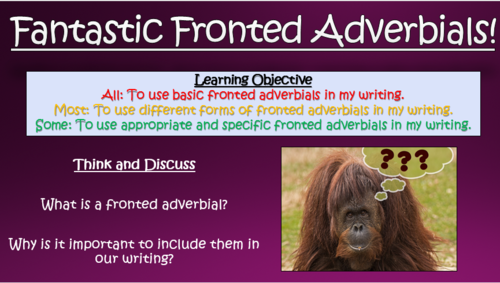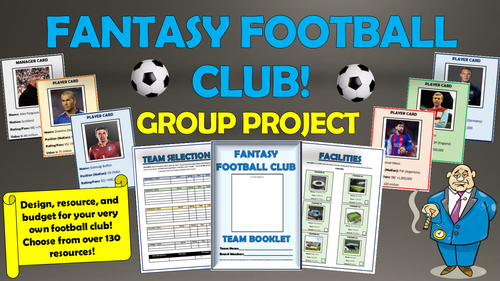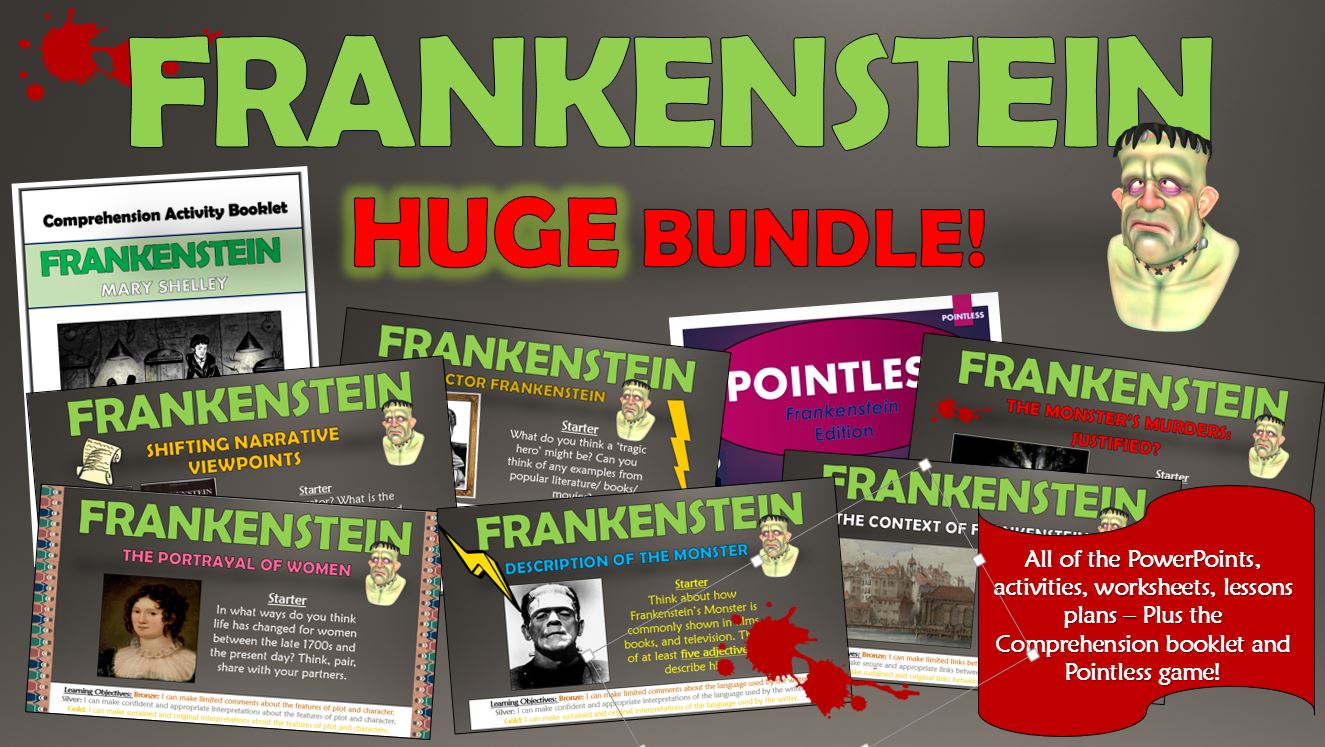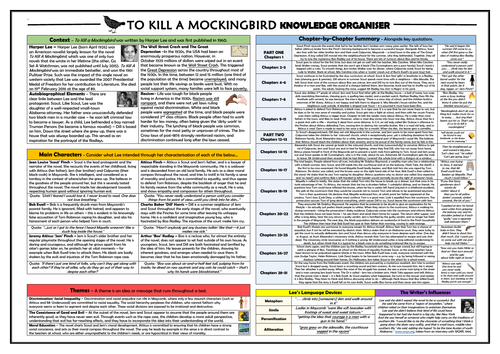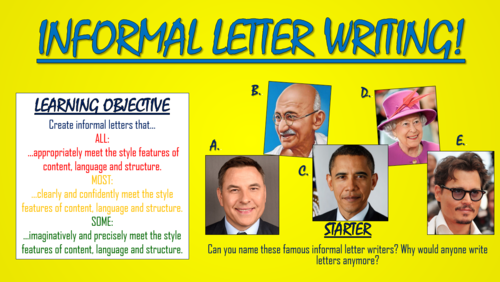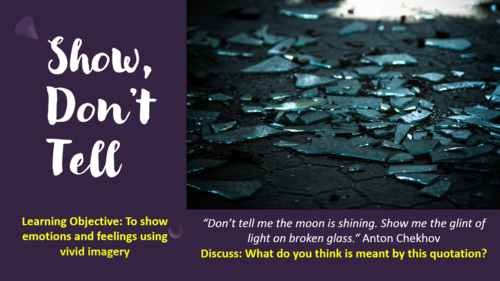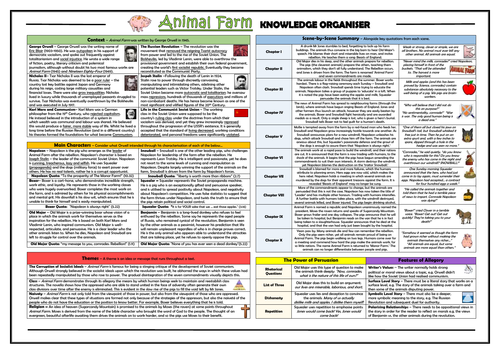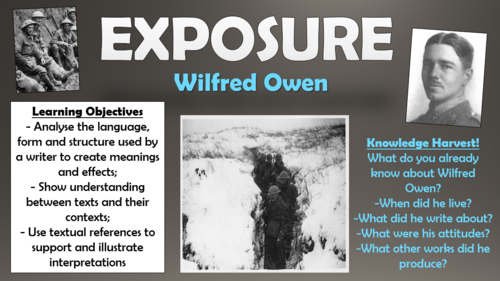
3k+Uploads
1896k+Views
2230k+Downloads
English
Bundle Sale

To Kill a Mockingbird Huge Bundle!
THIS BUNDLE CONTAINS ALL OF THE ‘TO KILL A MOCKINGBIRD’ LESSONS, IN ADDITION TO THE KNOWLEDGE ORGANISER, THE 30-PAGE COMPREHENSION BOOKLET, AND THE POINTLESS GAME!
This engaging, varied, and informative scheme of learning is designed to help students gain understanding, assessment skills, and key interpretations of Harper Lee’s novel ‘To Kill a Mockingbird.’ Made up of a wide-range of interesting and exciting lessons, students should complete this scheme having gathered vital skills in: interpreting the significant meanings of the novel, understanding the writer’s ideas within the text, analysing key characters, settings, and themes, and understanding Lee’s language devices.
Stimulating, visual, and easily adaptable, these lessons provide suggested learning objectives and outcomes for students of a wide-range of abilities - The vast majority of tasks are differentiated to allow for different abilities and needs in your classroom. Each lesson loosely follows this logical learning journey to ensure that students learn in bite-size steps:
Engaging
Defining/ Understanding
Identifying/Remembering
Analysing/ Creating
Peer or self evaluating.
All of the lessons are interactive, employ a variety of different teaching and learning methods and styles, and are visually-engaging. Resources, worksheets, and lesson plans are all provided.
Bundle Sale

Edexcel Time and Place Poems - Knowledge Organisers Bundle!
THIS BUNDLE CONTAINS KNOWLEDGE ORGANISERS FOR ALL 15 OF THE EDEXCEL TIME AND PLACE POEMS!
These clear, detailed and visually-appealing knowledge organisers offer complete reference points for students learning or revising the following poems from the ‘Time and Place’ anthology:
John Keats – “To Autumn”
William Wordsworth – “Composed upon Westminster Bridge"
William Blake – “Songs of Experience: London”
Emily Dickinson – “I started Early – Took my Dog”
Thomas Hardy – “Where the Picnic was”
Edward Thomas – “Adlestrop”
Robert Browning – “Home Thoughts from Abroad”
U A Fanthorpe – “First Flight”
Fleur Adcock – “Stewart Island”
Moniza Alvi – “Presents from my Aunts in Pakistan”
Grace Nichols – “Hurricane Hits England”
Tatamkhulu Afrika – “Nothing’s Changed”
Sophie Hannah – “Postcard from a Travel Snob”
John Davidson – “In Romney Marsh”
Elizabeth Jennings – “Absence”
Each organiser contains a number of detailed, clear, and colourful sections explaining the key elements of the poem:
Context;
Line-by-Line Analysis;
Poetic Devices/ Language Devices;
Themes;
Form/Structure;
Poems for Comparison;
The Poet’s Influences.
The resources are designed to be printed onto A4 or A3, and are provided as both PDFs and Word documents (so that you can edit should you wish to). All images used are licensed for commercial use and are cited on a separate document (included).
Bundle Sale

Stone Cold Big Bundle!
THIS BUNDLE CONTAINS ALL OF THE STONE COLD LESSONS, IN ADDITION TO THE COMPREHENSION BOOKLET, THE KNOWLEDGE ORGANISER AND THE POINTLESS GAME!
This engaging, varied, and informative scheme of learning is designed to help students gain understanding, assessment skills, and key interpretations of Robert Swindells’ ‘Stone Cold.’ Made up of a wide-range of interesting and exciting lessons, students should complete this scheme having gathered vital skills in: interpreting the significant meanings of the text, understanding the writer’s ideas within the text, identifying the traits of key characters, settings, and themes, understanding dramatic and language devices, and relating the text to its social and historical context.
Stimulating, visual, and easily adaptable, these lessons provide suggested learning objectives and outcomes for students of a wide-range of abilities - The vast majority of tasks are differentiated to allow for different abilities and needs in your classroom. Each lesson loosely follows this logical learning journey to ensure that students learn in bite-size steps:
- Engaging
- Defining/ Understanding
- Identifying/Remembering
- Analysing/ Creating
- Peer or self evaluating.
All of the lessons are interactive, employ a variety of different teaching and learning methods and styles, and are visually-engaging. Resources, worksheets, and lesson plans are all provided.

The Big Enterprise Project!
This engaging investigation activity allows students to use develop their innovation, creativity and collaboration skills to control the direction of their enterprise project.
The resource set guides students through the entire project, from conception to evaluation, and includes resources/ guidance for the following activities:
-Deciding upon different roles within their groups, in order to carry out multiple tasks effectively;
-Designing a company name and appropriate logo and slogan;
-Researching their product area, including competitors and USPs;
-Conducting market research;
-Budgeting;
-Detailed product design;
-Packaging design;
-Creating instructions for users;
-Formulating and presenting a persuasive pitch;
-Surveying the target audience for their feedback;
-Self-evaluating strengths and areas for development.
A comprehensive PowerPoint presentation guides students through the project.
There are at least a week’s worth of resources in here, enabling students to fully immerse themselves in the project. I orignally have used this with KS2 and KS3 students, but they could reasonably be adapted for students in KS4.
All images have been cited at the end of the PowerPoint presentation and are licensed for commercial use.

Fantastic Fronted Adverbials!
This engaging and detailed resource pack has been designed to make the learning of fronted adverbials (particularly prominent in the new curriculum) easily accessible, engaging and interesting for all children. Throughout the lesson, students learn to improve their skill at using appropriate, concise, and precise fronted adverbials within their own writing compositions. In addition to the comprehensive lesson, resources, and plan, it also includes a fronted adverbials writing mat to assist students in building their extended writing skills.
The lesson follows a clear, logical, bite-size learning journey, which guides students towards differentiated learning objectives. Over the course of this journey, they become able to:
- Define what fronted adverbials are;
- Identify fronted adverbials in sentences;
- Analyse and evaluate what it is that makes some fronted adverbials more effective than others;
- Write an extended piece with the employment of fronted adverbials;
-Peer/self-assess learning attempts.
This resource pack includes:
- A visually engaging whole-lesson PowerPoint presentation;
- A clear and interesting worksheet for the development task;
- An interesting short story for students to analyse;
- A hyperlink to an engaging and heart-warming video through a hyperlink in the presentation;
- A detailed lesson plan, complete with what the teacher and students should aim to achieve at each stage of the lesson.
All images are licensed for commercial use, and are cited on the final slide of the PowerPoint/ the bottom of worksheets.

Fantasy Football Club Group Project!
A Russian billionaire, Asman Veryrich, has approached you about setting up a new football club!
This exciting, engaging investigation activity allows students to control the direction of their own learning, through speaking, listening, discussing, and reasoning. I initially created these resources to provide something interesting for the students to engage with for their English Speaking and Listening discussions, but it has since been used across Maths, Art and Design, and PSHE departments, as well as by form groups and holiday activity groups, to build teamwork and collaboration skills.
Students get involved in all of the fun aspects of designing and setting up a new football club, including selecting a team of players, a manager, a stadium, and a training ground. They also design the team's club badge and football kits. They also need to use their skills of literacy to read and understand key evidence, and skills of numeracy to ensure that they keep their expenses within budget! What is more, groups can compete against one another to create the most successful team in the league, as all of the resources that they choose can help them to acquire valuable league table points!
Included in this resource pack are:
- Full PowerPoint lesson talking students through the process;
- An 8 page team booklet, used to create their designs and calculate their budgets;
- A pack of 96 player cards and 12 manager cards to select from (a combination of new and classic footballers are included, to ensure that this will never be outdated);
- Budget and recording sheets to track their progress;
- An A3 football pitch to strategise and select their team.
Considering the time and effort that it took to create these resources, I think that they offer exceptional value. Whenever I have used this activity before, it has taken at least 3-4 lessons, including the introduction, design process, presentations, and evaluation. I originally have used this with mixed ability Year 9 and 10 groups, but colleagues have adapted it easily for students of all key stages.
All images have been cited at the end of the PowerPoint presentation and are licensed for commercial use.
Bundle Sale

Frankenstein Huge Bundle!
THIS BUNDLE CONTAINS ALL OF THE FRANKENSTEIN LESSONS, PLUS THE 30 PAGE COMPREHENSION BOOKLET, THE KNOWLEDGE ORGANISER AND THE POINTLESS GAME!
This engaging, varied, and informative scheme of learning is designed to help students gain a valuable understanding of Mary Shelley's horror classic 'Frankenstein.' The lessons enable students to gain a comprehensive understanding of the key features of plot, character, context, and language, in addition to considering the key themes and ideas running throughout the text.
All of the resources that you need are included in the bundle: informative and engaging whole lesson PowerPoints, worksheets, activities, and lesson plans.
The bundle is made up of a wide-range of interesting and exciting lessons, including:
- The Context of Frankenstein;
- Victor Frankenstein - The Tragic Hero;
- Shifting Narrative Viewpoints:
- Shelley's Description of the Monster;
- The Monster's Murders - Justified?
- The Frankenstein Pointless Game
- Frankenstein Comprehension Booklet
- Frankenstein Knowledge Organiser
Stimulating, visual, and easily adaptable, these lessons provide suggested learning objectives and outcomes for students of a wide-range of abilities - The vast majority of tasks are differentiated to allow for different abilities and needs in your classroom. Each lesson loosely follows this logical learning journey to ensure that students learn in bite-size steps:
- Engaging
- Defining/ Understanding
- Identifying/Remembering
- Analysing/ Creating
- Peer or self evaluating.
All of the lessons are interactive, employ a variety of different teaching and learning methods and styles, and are visually-engaging.

Pigeon English - Knowledge Organiser/ Revision Mat!
This detailed and visually-appealing resource offers a complete reference point for students learning or revising Stephen Kelman’s ‘Pigeon English.’ It contains comprehensive sections on:
Context;
Chapter by Chapter Summary (with quotes);
Main Characters;
Themes;
Symbols and Motifs;
Key Terminology Definitions.
Key words and ideas are underlined for easy reference. The resource is designed to be printed onto A3, and is provided as both a PDF and a Word version (so that you can edit if you want to). All images used are licensed for commercial use and are cited on a separate document (included).

To Kill a Mockingbird Knowledge Organiser/ Revision Mat!
This detailed and visually-appealing resource offers a complete reference point for students learning or revising Harper Lee’s ‘To Kill a Mockingbird.’ It contains comprehensive sections on:
Context;
Chapter by Chapter Summary (with quotes);
Main Characters;
Themes;
Lee’s Language Devices;
Influences on the Writer.
Key words and ideas are underlined for easy reference. The resource is designed to be printed onto A3, and is provided as both a PDF and a Word version (so that you can edit if you want to). All images used are licensed for commercial use and are cited on a separate document (included).

Informal Letter Writing!
This stimulating and informative lesson develops students’ skill in creating informal letters that precisely meet the content, language and structural features of the form. In particular, they gain an in-depth understanding of how informal letters should be set out on the page, what information should be included within them, and what style they should be written in, in order to meet form, audience and purpose.
Students follow a clear and logical learning journey, in which they:
-Understand why letter writing is still important in the present day;
-Unjumble a model example of an informal letter in order to establish its structure;
-Work collaboratively to identify and analyse the content and language features in further model examples of informal letters;
-Create a success criteria for effective informal letters (although a ready-made success criteria is included);
-Write their own informal letters, using a structure strip and helpsheet (if needed) and the techniques that they have learnt;
-Peer/self-assess their writing attempts.
There are enough resources here really for two lessons, including:
-Visually engaging whole-lesson PowerPoint;
-Informal letters x 3 (based on The Simpsons, Batman, and Harry Potter characters)
-Informal letters structure strip;
-Informal letters helpsheet;
-Step-by-step lesson plan.
All images are licensed for commercial use, and are cited on the final page of the slide.

Show, Don't Tell - Writing About Emotions!
This engaging and highly-purposeful lesson enables children to write about emotions and feelings using vivid imagery.
Children learn how to show, not tell in their writing, focusing on precise details relating the senses. This helps to make their writing more immersive - painting an image in the mind of the reader with their words.
Children learn through:
-Defining and understanding what is meant by showing, not telling;
-Considering how each of the major emotions/ feelings can be shown;
-Turning their ‘showing’ simple sentences into compound and complex sentences;
-Editing and enhancing their showing sentences through consideration of precise verbs, adverbs and the use of analogies.
Provided in this resource pack are:
-Colourful and comprehensive PowerPoint presentation, offering a step-by-step guide through the lesson;
-Showing Emotions table template;
-Showing Emotions helpsheet (for LAP students).
The worksheets/ templates are provided as Word (for ease of editing) and PDF (to prevent formatting issues between devices).
The lesson was originally created for children in upper KS2, however with minor adaptations could easily be suitable for those in lower KS2 or lower KS3.

Animal Farm Knowledge Organiser/ Revision Mat!
This detailed and visually-appealing resource offers a complete reference point for students learning or revising George Orwell's 'Animal Farm.' It contains comprehensive sections on:
- Context;
- Chapter by Chapter Summary (with quotes);
- Main Characters;
- Themes;
- Features of Allegory;
- 'The Power of Persuasion (in the speeches of Old Major and Squealer).
Key words and ideas are underlined for easy reference. The resource is designed to be printed onto A3, and is provided as both a PDF and a Word version (so that you can edit if you want to). All images used are licensed for commercial use and are cited on a separate document (included).

Writing Recounts - Lower KS2 Knowledge Organiser!
This clear, detailed and visually-appealing resource offers a complete reference point for year 3-4 children when writing recounts. The organiser is also perfect for teachers, parents and English subject leaders - aiding their planning and supporting of children’s knowledge development for this writing text type.
The organiser has a particular focus on the content, language and structural features required to write effective mystery stories at lower KS2. It contains distinct sections covering:
-Recounts Overview;
-Content: Settings, Characters, and Plot;
-Language: Descriptive Devices, Dialogue, Conjunctions, Punctuation Checklist and Word Mat;
-Structure - Titles, Planning Techniques and other tips;
-Key Vocabulary
The content is fully aligned with the age-related expectations for Lower KS2 children in writing. The resource is designed to be printed onto A3, and is provided as both a PDF and a Word version (so that you can edit if you want to).

Northern Lights - Setting Descriptions!
This engaging and informative lesson enables students to make precise interpretations of the descriptive language used by Philip Pullman in his descriptions of settings in ‘Northern Lights.’ They also learn how the depiction of settings can have a profound impact upon the tone and atmosphere of a novel, and apply this understanding (along with their knowledge of the key language devices) to form their own vivid and imaginative descriptions of places.
The lesson follows a step-by-step learning journey, in which children learn through:
Understanding the power of places and settings, especially the impact that they have on atmosphere and tone;
Defining each of the different types of descriptive devices, through completing an interactive group activity;
Reading extracts from the text in which Pullman describes ‘The North’ and ‘The Bear Palace,’ and identifying the language techniques used to paint an image of place in the minds of the readers;
Analysing the effectiveness of each of Pullman’s descriptive devices;
Creating their own description of an awe-inspiring place, utilising appropriate and effective descriptive devices throughout;
Peer assessing each other’s learning attempts.
Included is:
Whole lesson PowerPoint - colourful and comprehensive;
Cards for the Card Sorting Activity;’
Extracts from Northern Lights;
‘Bear Palace’ analysis worksheet;
Writing to Describe Helpsheet
All resources are provided in Word (for easy editing) and PDF (to ensure formatting remains fixed between different computers).
There are also opportunities for group learning, speaking and listening, peer assessment, and whole class discussion. I originally used these resources with year 7/8 classes, however colleagues have used them for between years 5 and 10 with some adaptations. The PowerPoint is in the zip file.
All images are liensed for commercial use, and image rights are listed on the last page of the presentation.

Tissue - Imtiaz Dharker - Knowledge Organiser/ Revision Mat!
This detailed and visually-appealing resource offers a complete reference point for students learning or revising Imtiaz Dharker’s power and conflict poem 'Tissue.’ It contains comprehensive sections on:
Context;
Line-by-Line Analysis;
Poetic Devices/ Language Devices;
Themes;
Form/Structure;
Poems for Comparison;
The Poet’s Influences.
Key words and ideas are underlined for easy reference. The resource is designed to be printed onto A3, and is provided as both a PDF and a Word version (so that you can edit if you want to). All images used are licensed for commercial use and are cited on a separate document (included).
Bundle Sale

Power and Conflict Poetry Knowledge Organisers Huge Bundle!
THIS BUNDLE CONTAINS KNOWLEDGE ORGANISERS FOR ALL 15 OF THE POWER AND CONFLICT POEMS!
These clear, detailed and visually-appealing knowledge organisers offer complete reference points for students learning or revising the following poems from the ‘Power and Conflict’ anthology:
Exposure - Wilfred Owen;
Bayonet Charge - Ted Hughes;
The Charge of the Light Brigade - Alfred, Lord Tennyson;
Poppies - Jane Weir
War Photographer - Carol Ann Duffy
Kamikaze - Beatrice Garland
Ozymandias - Percy Bysshe Shelley
My Last Duchess - Robert Browning
Storm on the Island - Seamus Heaney
Checking Out Me History - John Agard
Tissue - Imtiaz Dharker
Remains - Simon Armitage
The Prelude (Extract) - William Wordsworth
The Emigree - Carol Rumens
London - William Blake
Each organiser contains a number of detailed, clear, and colourful sections explaining the key elements of the poem:
Context;
Line-by-Line Analysis;
Poetic Devices/ Language Devices;
Themes;
Form/Structure;
Poems for Comparison;
The Poet’s Influences.
The resources are designed to be printed onto A3, and are provided as both PDFs and Word documents (so that you can edit should you wish to). All images used are licensed for commercial use and are cited on a separate document (included).

Similes and Metaphors in Popular Music!
This interesting and highly stimulating lesson enables students to demonstrate a developed and sustained understanding of the effect of figurative language in popular music texts. In particular, students learn to explore the meanings behind similes and metaphors across songs from a range of genres, considering the effect upon the whole text and the intended audience. As one would expect, Students love learning about similes and metaphors through popular music, and this lesson can really help to open students' eyes to how language can be crafted for effect. This has numerous benefits in later poetry and descriptive writing lessons.
The lesson follows a clear, logical, bite-size learning journey, which guides students towards differentiated learning objectives. Over the course of this journey, they become able to:
- Define and identify similes and metaphors;
- Explain the similarities and differences between songs and poetry;
- Observe and listen to several examples of similes and metaphors in popular music examples;
- Understand and analyse the effect of similes and metaphors upon meanings and the reader;
- Apply their knowledge of why similes and metaphors are used to a range of contexts and musical genres;
- Collaborate and present their key findings about similes and metaphors in songs to their classmates;
- Self-assess their learning attempts.
This resource pack includes:
- A visually engaging whole-lesson PowerPoint presentation;
- Link to an online compilation video of similes and metaphors in popular music;
- 3 x lyrics analysis worksheets of varying difficulties (Katy Perry, Train, and Florence and the Machine - all clean)
- A detailed lesson plan, complete with what the teacher and students should aim to achieve at each stage of the lesson.
All images are licensed for commercial use, and are cited on the final slide of the PowerPoint.

Exposure - Wilfred Owen
This engaging, comprehensive lesson aims to improve students’ understanding of Wilfred Owen’s WWI power and conflict poem ‘Exposure’ with particular focus upon the language, structure, and subject matter used within the poem. By the end of the lesson, students demonstrate their knowledge of the text analytically, through assured, appropriate, and sustained interpretations.
The lesson follows a step-by-step learning journey, in which children learn through:
Considering the meanings of the word ‘exposure’ and inferring what this may suggest about the meaning of the poem;
Securing contextual understanding of the conditions and weather faced by WWI soldiers;
Reading and interpreting the poem, using a provided line-by-line analysis, and interactive group activities;
Developing their understanding through inferring and analysing key language and structural choices;
Analysing how the themes of suffering and misery are conveyed through Owen’s language and structure choices;
Self/ Peer assessing each other’s learning attempts.
Included is:
Whole lesson PowerPoint - colourful and substantial; (including hyperlinks to informative and videos)
Copy of poem (freely available online);
Deeper thinking worksheet;
Analysis template with success criteria for creating well-structured responses;
Comprehensive lesson plan.
All resources are provided as word documents (for easy editing) and PDF documents (to ensure consistency of formatting between computers).
There are also opportunities for group learning, peer assessment, and whole class discussion. This was originally taught to middle-ability year 10 and 11 groups, but can easily be differentiated for groups of different ages and abilities.
All images are licensed for commercial use, and image rights are listed on the last page of the presentation.

Lord of the Flies Knowledge Organiser/ Revision Mat!
This detailed and visually-appealing resource offers a complete reference point for students learning or revising William Golding's 'Lord of the Flies.' It contains comprehensive sections on:
- Context;
- Chapter by Chapter Summary (with quotes);
- Main Characters;
- Themes;
- Golding's Language Devices;
- Features of Form.
Key words and ideas are underlined for easy reference. The resource is designed to be printed onto A3, and is provided as both a PDF and a Word version (so that you can edit if you want to). All images used are licensed for commercial use and are cited on a separate document (included).

Pigeon English - Comprehension Activities Booklet!
This resource booklet contains a wide range of age-appropriate, engaging, and meaningful comprehension activities for use throughout the reading of Stephen Kelman’s ‘Pigeon English.’ Teachers have found them particularly useful in exam revision, comprehension tasks, or guided reading sessions.
They are perfect for aiding the progress of students towards meeting the KS4 expectations within the National Curriculum framework - this makes the tasks suitable for all examining bodies. Students have found these resources extremely engaging, and for teachers there is explicit information within each task regarding which comprehension strands the task is designed to demonstrate.
They also relate to key extracts, characters, and themes from the story, ensuring that students gain a deep understanding of the text.
Activities within the booklet include:
'Context: Modern Britain - to aid students with ‘Drawing on knowledge of the purpose, audience and context of the writing, including its social, historical and cultural context and the literary tradition to which it belongs, to inform evaluation;’
‘Kelman’s Description’ - to aid students with ‘Analysing a writer’s choice of vocabulary, form, grammatical and structural features, and evaluating their effectiveness and impact;’
‘X-Fire’ and ‘Lydia’ Profiles - to aid students with ‘Seeking evidence in the text to support a point of view, including justifying inferences with evidence;’
‘Editing the Text’ - to aid students with ‘Making an informed personal response, recognising that other responses to a text are possible and evaluating these.’
Plus many, many more activities (the booklet is around 30 pages in length!) I’ve also added it as a PDF in case the formatting differs on your computer.
All images are licensed for commercial use, and are cited on a separate document (included).





